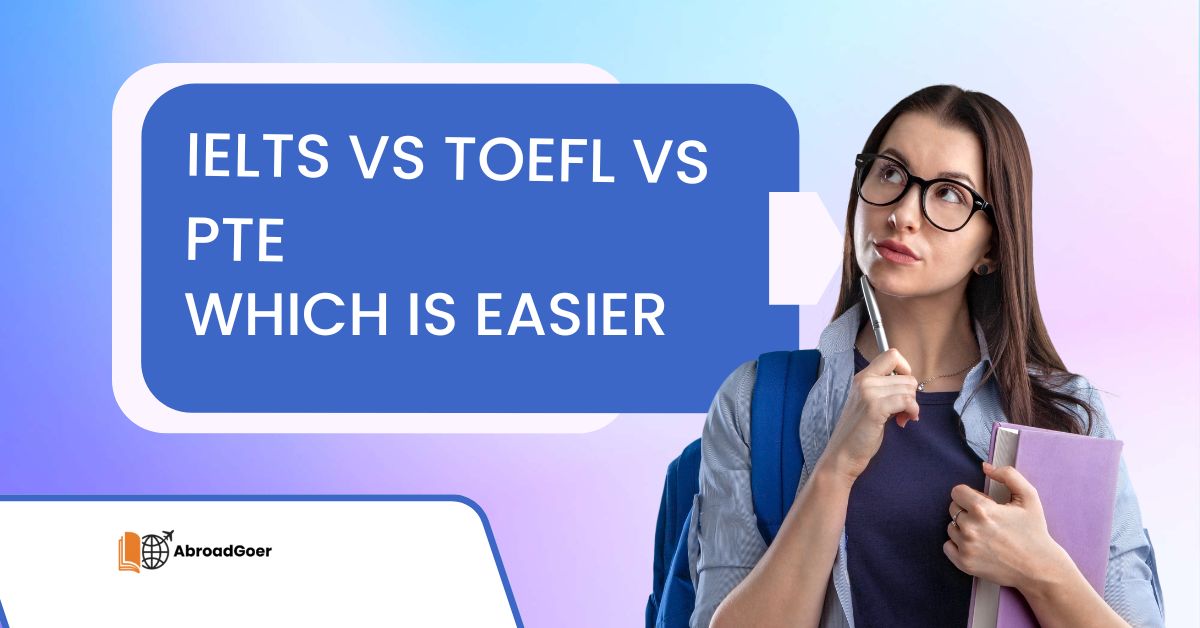IELTS vs TOEFL vs PTE which is easier
Crossing the maze of English proficiency exams, such as IELTS vs TOEFL vs PTE, which is easier, can be quite a daunting task, a rationale that many of my students repeat to me before embarking on their study or work abroad. You will be required to prove your English language proficiency, and the big three are IELTS, TOEFL, and PTE. First, everyone asks the obvious question: Which one is easier?
Truthfully, there’s no easy, one-size-fits-all answer, because the best test for you depends on many factors relating to you and where you’re planning to apply. Whether you are taking it for universities in a country like Canada or Australia, global migration, or work, the completion of one of these exams is a hard-won process that starts from the minute you start to think about what course options you might have. Don’t worry; this article attempts to guide you to compare IELTS, TOEFL, and PTE 1 to choose based on your comfort level.
Each of the following three major tests tests your knowledge of reading, writing, speaking, and listening to/reading English. IELTS is now clearly the flagbearer in the battle of the test, endorsed worldwide with a large footprint all over the world, it is trusted by more than 12000 organisations and has test centres in over 140 countries, and yes, Pakistan! Once upon a time, TOEFL was practically the only game in town for non-native users of English in this market of university-bound test-takers (at least for those with an emphasis on English-based subjects or choice (English medium) and close behind it stands the TOEIC.
PTE Academic, the new kid on the block, is an English language test that must be given via computer and that evaluates an individual’s language learning potential. TOEFL now has to compete with some- IELTS and PTE. We’ll have to parse the differences in scoring systems? and whether your accent might make a difference.

Just to update, you would need to clear the exam before you could apply to Foreign universities or for work/immigrating. Most international universities take scores from any of these tests (which are usually valid for two years), so you’ll need to figure out which test gives you the most options or better prepares you for study or work abroad.
It also depends on such factors as which exam centers are near you and how much you’re willing to pay. Posed to help you find the answer, have a look at this comparison: IELTS Academic vs TOEFL iBT vs PTE Academic. After you read, you’ll know exactly which exam is right for you, and you will be able to locate a test date and register. It’s all about grasping these 8 crucial distinctions.
The IELTS Academic Path
If you’re focusing on IELTS vs TOEFL vs PTE which is easier to prove your English language skills for higher education or professional registration, you’ll want to consider the IELTS Academic path. I’ve helped countless students navigate this process, and I’ve experienced how knowing its anatomy can make the journey more manageable. This test is meticulously thought out and consists of four tests: Listening, Reading, Writing, and Speaking. The importance of each category is equally significant in the assessment of your English language ability.
In the Listening part, you’ll listen to four different recordings of native speakers and answer questions about the content of each one. In Academic Reading: 3 texts to read and 40 questions to answer to demonstrate your understanding.
The Academic task in the Writing module consists of 2 tasks to be solved in 60 minutes. The first typically describe visual information (a graph, table, chart, etc) using your own words. The second is an essay response to a provided point of view, problem, or argument and is written in formal style. Finally, Listening, which runs for 11-14 minutes, consists of three parts. You will begin speaking about yourself, continue to describe or give your opinion on something, and end with something more conceptual or abstract, which you discuss with the examiner.

The IELTS exam follows a band scoring system from 0 to 9. You receive a band score for each of the four sections and then a total score. These band scores were rounded to the nearest 0.5, so a score of 6.75 would be recorded as 7. The band score of 9 is an expert English speaker who can talk articulately and accurately, whereas 5 just means that you are learning how to use English, but you are struggling with it.
The International English Language Testing System (IELTS) is one of the most used exams around the world more than 10,000 organizations and administrations in immigration with do accept and recognize this testing system. Many who are applying for immigration to the UK, Canada, Australia, United States of America also are likely to take IELTS General Training form of the test, as is stipulated by the respective government and immigration authorities, the General Training Format is one of the two versions available and takes the place of the other kind of test IELTS Academic. The test is generally taken over two days and covers the four sections listed below.
TOEFL is an internationally recognized English language test for foreign students to take to study in the United States and many other countries, which is similar to the GRE test. I’ve helped numerous students pursue studies in the States, and I have seen how they’ve prepared for this test. Introduced in 1964, or 16 years before IELTS (which was launched in 1980), TOEFL likewise tests skills in reading, writing, listening, and speaking. But really, the likeness ends there.
Exploring the TOEFL iBT Experience
The TOEFL iBT exam consists of 4 sections. The Reading section lasts 54-72 minutes, and you will read 3 or 4 passages from academic texts and answer 30-40 questions. The Listening section is 41-57 minutes lon,g and you will listen to 4 native speaker recordings and answer 28-39 questions.
The Speaking section is a mere 17 minutes, during which time you must state your opinion on a familiar subject and answer a few questions based on reading and listening tasks. The Writing section will allow you 50 minutes to finish 2 tasks in which you will write essay responses and support your opinions. Scores: While the IELTS score is rounded to the next 0.5 in cases of decimal points, each of the sections of the TOEFL is on a scale of 0 to 30, making it possible for a test taker to score as high as 120. As opposed to a plain, rounded score, TOEFL calculates raw scores and scaled scores.

Raw scores are simply the number of questions on which your score is based within a particular section (eg, if you answer 30 out of 34 questions in a section correctly, that will be your raw score for that section). But on your report card, you have a scale score. This raw-and-scaled-score system is intended to ensure equitable scores for students who may take a more difficult form of the test. If they did worse than their peers on an easier version, it could be seen as an unfair measure of their English-language skills.
They provide a way to even the playing field. Cest a noter : le nombre de questions dans les parties Lecture et Écoute peut varier selon la longueur, le type et la difficulté de ou des texte et des audio. Right now, unlike IELTS, all four TOEFL sections are delivered online unless in specific countries.
The PTE Academic Exam
The PTE Academic (known as the Pearson Test of English) is the newest of the major English language tests, established in 2009. From the many students I have worked with, I have seen how its distinctive format and scoring can either draw you in — or make you think twice. Unlike IELTS, whose total score is the mean of the scores of the four skill sections Reading, Listening, Writing, and Speaking, the PTE rating system has its standard, the Global Scale of English. It’s a 10 to 90 scoring system (with 90 being the highest level of language command) and claims to provide students with the opportunity to measure their language command down to the fine details.
Rather than adopting mere averages, the scoring considers things like oral and written fluency, pronunciation, spelling, and vocabulary. There are some who think that the IELTS scoring is simpler and clearer, so it could be a factor that contributes to the preference between IELTS and PTE. In the end, if we compare PTE vs TOEFL vs IELTS difficulty, the scoring mechanism is just one part; comfort with the test style is the other.

PTE: The full form of PTE is Pearson Test of English, which is a computer-based English language test that checks reading, listening, writing, and speaking. Just like IELTS, PTE Core and PTE Academic are the two tests offered by PTE. The PTE PTE Core is generally for immigration, and PTE Academic is useful for admission to institutions. PTE is accepted by a wide range of schools worldwide, including colleges in Australia, the UK, Europe, and the U.S. Learning the former can also provide for immigration purposes to Australia and Canada.
There are 3 sections to the PTE Academic examination. The Speaking & Writing section lasts from 54 to 67 minutes, and you’ll be asked to perform some tasks that include greeting someone, reading aloud, recounting a story, summarising a text, and writing an essay, among others. The Reading section takes 29-30 minutes and includes tasks such as filling in the blanks, answering multiple-choice questions, and reordering paragraphs. Finally, the Listening portion lasts 30 to 43 minutes and consists of answering questions based on audio or video clips that you hear or watch.
The speaking and writing sections have been blended into one online exam. There are more and more institutions accepting PTE scores, and some countries also accept PTE as part of the visa application, such as Australia and New Zealand. The IELTS, TOEFL, and PTE are all designed to gauge your skills in speaking, reading, listening, and writing English, but they are assessed in different formats.
TOEFL also consists of 4 sections (Speaking, Listening, Reading, Writing), and takes 3 hours. The IELTS test also comprises four sections (speaking, reading, and listening) and the overall duration is 2 hours and 45 minutes. The PTE exam is three hours long and features twenty diverse question formats, ranging from multiple choice (MCQs) to essay writing and interpreting information.
Choosing Your Test Format
One of the realistic considerations when you are comparing IELTS, PTE, and TOEFL is the format of the test. Both PTE and TOEFL are computer-based exams only. The more you can do the IELTS on a computer or paper. For some people, this option may be especially crucial if they are more comfortable holding a pen to find the responses rather than typing on a keyboard. This familiarity might reduce test anxiety for some students and could affect how they perform.
The Speaking Assessment: Human Touch vs. Machine
One major difference between the three tests is the kind of spoken English you are graded on. In the Speaking section of the IELTS test, you will be speaking to a real person – an IELTS examiner – in a private room. This means you can ask questions if you don’t understand something, and examiners are trained to work with people from a variety of backgrounds, so you don’t usually have to be concerned about your accent not being understood.
On the other hand, the speaking parts of PTE and TOEFL will have you facing a robot, speaking into a microphone in a room with other test-takers who will also be doing the same. Both the questions and the instructions are prerecorded. If you like a more human, personalised touch during your test, the IELTS test might be more your thing
The Question Formats
When considering IELTS, PTE, and TOEFL, the questions you are asked can also determine which format feels easier. TOEFL Multiple-Choice Questions: TOEFL is a test of multiple-choice questions. Both IELTS as well as PTE have a mix of short-answer and multiple-choice types of questions. Ultimately, the decision often comes down to which test you are most comfortable with, that style of material, and which task organization you prefer. This article is here to make it easier to figure out which test is better suited to your strengths.
Key Differences Between TOEFL, IELTS, and PTE
Selecting the perfect English language test can sometimes seem like a big decision. As the three exams, IELTS, TOEFL, and PTE have the same motive of testing your English in reading, writing, speaking, and listening, there are a few major differences to know. Let’s look at some of these:
- Duration and Mode: Each exam is of about 2 hours duration. But the delivery mode is different. Choose between Pen-and-paper or Computer in IELTS, TOEFL iBT, and PTE Academic are 100% computer-based. This may or may not be a big consideration, depending on what you find most comfortable.
- Scoring: The Range of scores varies between Tests. IELTS score is between 0 – 9.0, TOEFL is between 0 – 120, and PTE Academic is between 10 – 90. The score reports for all three tests are typically valid for 2 years.
- Cost: The cost of all three tests is almost the same, roughly USD 250 to INR 17K with approximate rates in India (it may slightly vary for TOEFL iBT, it’s around INR 17,117 Approx/-). I usually charge by debit card or credit card.
- Difficulty The test difficulty level is a matter of perspective, and there’s no consensus on which test is easier or harder to grade. Some opinions say PTE is not going to be in demand because PTE itself automated test where the grading part is done by computer, so maybe the test is less biased and maybe the easiest(test) among all, except tell speaking and writing, because they contain AI. It also has no transition time when you go from one part of a section to the next, so it could be faster. But that also leaves him less time to think. You do have the option to write your essay, but the human rating and an association of bias could result in variance. The TOEFL, which is a multiple-choice test, is often viewed as medium difficulty.
- Test Format and Content: The content measures your competence in four skills; however, it does so through different formats. The TOEFL test has short lectures, long conversations, and reading texts that are accompanied by multiple-choice and fill-in-the-blank items , and a new task called ‘writing for an academic discussion’. IELTS is in the same format with multiple-choice, gap-fill type questions, one essay, a summarization of facts from graphic information, and a spoken interview based on a familiar topic.
- PTE, which is the latest addition, has a bit different pattern where you will have to write an essay, a few questions, and tasks related to grammar, speaking, listening, and comprehension.
- Available Score Reports: The Time to view score reports on the website fluctuates. TOEFL issues the Scorecard within 4-8 days after the examination. For IELTS, the official report is accessible after 13 days for pen and paper and 1-5 days for online exams. Results: The quickest of the 3 is the PTE, where candidates are provided the results in 48 hours.
- Acceptance in Various Countries: IELTS is biased towards UK or Australian English, so having an IELTS score might be more appreciated in Europe and Australia. TOEFL and PTE are a bit slanted toward American English, and TOEFL is more accepted in the US universities. Although PTE is a much newer entrant, it is recognised in Europe, Australia, and, albeit, in some of the Ivy League institutes such as Harvard and Yale.
- This comparison underscores the fact that the right test for you will depend on your goals and plans, and the programs and schools to which you are applying. Think about what you are good at; if you like MCQs, online interviews, and keyboarding tests, maybe you are even made for TOEFL. If you want quick results and like short essays, maybe PTE is easy for you. If you do great in face-to-face interviews, and you love writing short answers more than MCQs, then IELTS could be the one for you.
Comparing PTE and IELTS: Which Might Be Easier?
Both the PTE and IELTS exams measure the four areas of the English language: speaking, writing, reading, and listening. Both test patterns are somewhat similar as they test in these common sections, except that the PTE is a bit shorter as its speaking and writing sections are integrated into two sections instead (still tests four skills though). There may be some test takers who appreciate the coherent feel of this unified style.
However, both PTE and TOEFL offer one major advantage compared to IELTS, that is, you can retake one section only. With IELTS One Skill Retake, if you think you did not do well in one part, you can give it another go, without giving the whole test again. In case you feel you got a low PTE or TOEFL score in one skill, you will need to re-take the exam in all four sections only in order to practice it. For many test-takers, this one-skill retake option with IELTS can be a real advantage.
Global Recognition of IELTS
For those hoping to apply to varied universities in different countries to study or work, widely accepted options will be key. Please remember, PTE is not accepted in a lot of the places where IELTS is. Although some 3,500 institutions accept PTE scores, 12,000 other institutions in more than 130 countries can have complete confidence in the accuracy of IELTS’ assessment of English language skills. This includes immigration offices, universities, and professional bodies (for example, nursing councils and medical boards) in primary visa destinations such as the UK, USA, Canada, and Australia.
As IELTS is the English proficiency test valid for the job market over the last few decades in many destination countries like Canada, USA, Australia, New Zealand, UK, Ireland, Germany, and Singapore, it also makes the process to apply for different universities or countries easy. It is this consistency and attainability that make IELTS the world’s most preferred English test for migration.
PTE v IELTS: Which score is better for work or study visas?
Countries such as Canada, Australia, New Zealand, Singapore, Germany, and the UK make use of points-based immigration systems. For instance, Superior English can get you 20 points in the direction of an Australian Permanent Resident (PR) Visa. Previously PTE score of 79 has been deemed equivalent to an IELTS score of 8 in some ability skills, which had been defined as Superior English in where the IELTS evidence of a score of 8 in speaking and listening, and 7 in reading and writing.
However, the updated requirements are 84 points in PTE for the same level. The changes throw those with 79 scores in speaking into limbo, as it’s still not clear how this will affect their future visas or work permits, causing mental strain when attempting to figure out how to continue life. In contrast to this, IELTS band scores are of a highly consistent and steady level and have been used for over 30 years, which will give you trustworthy feelings while applying visa.
Free Preparation Resources: IELTS Leads the Way
When comparing IELTS vs PTE, one must note that free IELTS prep material is provided by the British Council. They have a great online IELTS preparation package (the IELTS Ready Pack) which goes over two levels; other than that, they are like any other test provider. An IELTS Ready Member is free before your exam date with exclusive access to a planning video, IELTS mock computer test to practice, sample answers Writing test and Speaking test, and more.
And just as an aside, once you have reserved your IELTS test date with the British Council (and you can book way ahead of time), you get access to IELTS Ready Premium for free too. This premium section includes 40 practice IELTS tests and includes feedback on how to improve in your Listening tests and your Reading tests, as well as your speaking and writing skills. The IELTS Ready Premium library is made you to improve swiftly and dramatically. 94% of you said you would recommend this IELTS preparation material to friends, and 94% also said that preparing with it helped you get the score you needed.
Flexible Test Formats: IELTS Provides More Choices
One of the key differences between IELTS and PTE is the option to take a test format of your choice in IELTS. Whereas during the PTE test, your speaking is recorded using a microphone, and your score is produced by artificial intelligence, and PTE as well as TOEFL Speaking Listening are always taken in a room with other test-takers talking all around you which people online in chatrooms constantly complain is very distracting noize, IELTS gives you more choices to get comfortable and score your finest.
You can also take the IELTS Writing test and Reading test on paper or computers, or even online, whichever one you feel is most user-friendly. Not to mention, when you take an IELTS Speaking exam, you will be speaking with an examiner directly in person (in some cases) or remotely via a live video call. This way of your test allows you to focus better as your examiners are usually friendly and the environment is typically a smaller and less noisy room, which helps make you feel more comfortable in taking the test, unlike the potentially tense environment of the PTE and TOEFL speaking section.
PTE is computer-marked (AI), meaning no human is involved in the marking process, and the IELTS test is human-scored, but thinking that the PTE scoring system is fairer to your accent is not exactly the whole truth. As a matter of fact, in the IELTS Speaking exam, you should not even have to worry about your accent, as the IELTS examiners with the British Council are specifically trained to comprehend a variety of accents.
At the same time, an automatic marking system is not always fairer, since a computer cannot always detect the lilting nuances of your pronunciation and speak your language as well as someone else, and this may also influence your scores in the Reading and Speaking sections of the exam.
You can miss questions and return to them once done, meaning you’re not wasting time & it’s all in the same little block, whereas in PTE you can’t move on until you answer the question other then them letting you on the computer & because it all done by computers your answer must suit that 1 & only answer, and if you miss it, that’s it. Also, don’t forget the special ‘IELTS One Skill Retake’, which means that you can retake only 1 module of the exam to boost your score, something you won’t find with PTE Core and TOEFL, where to gain a better score in one aspect of your test, you will need to retake all 4 components of your test
PTE Vs IELTS Vs TOEFL: Which test results are faster?
PTE generally is the quickest at providing your test results, with results available in as little as 2 days in some cases. You can check your TOEFL results online around 6 days after you took the test. For IELTS Computer or IELTS Online, you receive results 3 to 5 days after the test. But if you do paper-based.
IELTS, you will have to wait longer to see your results, up to 13 days, even though you get as many as 5 complimentary hard copies of the Test Result Form to hold on file. Critical as well, understandably, PTE, IELTS, and TOEFL all have digital reports that can be sent directly to the selected immigration departments if you have their respective account numbers at the time of the time.
Comparing Test Security: IELTS, PTE, and TOEFL
All three tests, which include IELTS, PTE, and TOEFL, are underpinned by test security to maintain fairness. For both the TOEFL and PTE exams, you probably only need your passport as an identification document. Besides, with pte, you are always required to do this unsystematic biometric hand scan before entering the exam hall.
IELTS provides a bit more leeway, as you can use either your national ID card or your passport as proof of identification. Instead of a biometric hand scan, they usually just snap a picture of you. In addition, British Council IELTS tests are frequently held at official test centers, also providing up-to-date facilities and the best conditions for you to do your best, but in a secure environment
What is the difference between GRE, TOEFL, IELTS, and GMAT?
I think it is important to stress that IELTS and TOEFL are tests to measure your English, and that are known to almost all universities in the world to accept someone for a number of disciplines, both bachelor’s and master’s, while GRE/GMAT are two other things! TOEFL, Test of English as a Foreign Language, is an internationally recognized test for foreign language speakers. It is largely required by US universities and foreign exchange students.
It evaluates a student’s ability to read, write, listen, and speak in English at a college/university level and institutions of higher education, as well as scholarship agencies use the test to evaluate student preparedness for post-secondary entrance, and more. Formerly, there have been three forms of the TOEFL: the Paper-Based (PBT), Computer-Based (CBT), and Internet-Based (iBT); the entrance exam is currently in two formats: the paper-based test (PBT) and the Internet-based test (iBT).
For example, in Armenia, iBT is the only offered and priced at US$150, with subscores ranging from 0 to 30 and combined, which range from 0 to 120. GRE (Graduate Records Examinations) is accepted by some Master’s programs (graduate study) in the world. The GRE general test is divided into three sections: Analytical Writing, Verbal Reasoning, and Quantitative Reasoning. On a typical computer-based test, the test-taker first takes the Analytical Writing section (60 minutes). This is followed by 2 sections of Verbal Reasoning, each with 20 questions to be completed in 30 minutes.
IELTS (International English Language Testing Service) is not the same as TOEFL since TOEFL centres around American English and IELTS on British English. But these are both intended for foreign learners. Several UK, Australian, Canadian, and New Zealand higher education institutions and various international programs require IELTS. It is an assessment of the English language ability of a person in English Listening, Reading, Writing, and Speaking, when applied for higher studies or work in countries where English is the Language of Communication.
Although most international students can take either the TOEFL or IELTS, some colleges may have a clear preference (the IELTS is British, while the TOEFL is American). For example, you cannot get a student visa in Australia without an IELTS score, so it’s worth checking into this testing requirement at the university level. Finally, the GMAT and Graduate Management Admission Test measure the knowledge and skills of students who are seeking admission in business and management at an advanced level.







